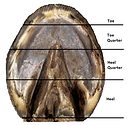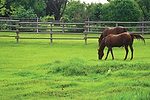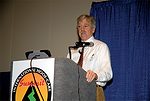Advertise Follow Us
Items Tagged with 'underrun heal'
ARTICLES
The prevalence of caudal foot problems leads Hall Of Fame farrier to spell out the critical, yet elusive, description
Read More
Dig Deeper When Tackling Inflammation
Examining the hoof, diet, gut health and stress can bring clarity
Read More
Considerations For Successful Management Of Underrun Heels
Two veterinarians and a farrier survey considerations for addressing this foot condition
Read More
Trimming and the Hoof-Pastern Axis
Case study supports theory that trim is more important than shoe choice in correcting broken-back bony column alignment and easing caudal heel problems.
Read More
Thorough Lameness Exam Starts Before you Pick up a Hoof
Equine veterinarian urges Summit attendees to use more than their eyes when evaluating horses
Read More
Apply Two Basic Principles to the Long-Toe, Low-Heel Hoof
Trim away the bent horn tubules to get down to the straight ones, and deal with each foot on its own merits, says a noted farrier and teacher
Read More
Help For That Last Furlong
Standardbred shoer says small improvements can pay off big at the track
Read More












